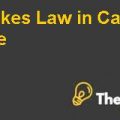
DuPont Corporation: Sale of performance Coatings Case Solution
Introduction:
In January 2012, Ellen Kullman, the CEO was reviewing the annual report of DuPont and its performance in each past year. The company offers various products such as Agricultural, Electronics, Nutrition & health, performance chemicals, performance coatings, Industrial Biosciences, etc. A rumor aired that DuPont wanted to sell the company and were searching for potential buyers to invest in the company as per their stated targets.
The CEO had to decide whether to retain the Company’s performance coatings or to sell them. Therefore, he had to find a large division that could invest under DuPont’s control, which decided the value of $ 4 billion from strategic buyers to invest. The CEO evaluated company's performance with adjusted present value models for the stand-alone business and reflected the potential value under price earning ownership. The objective of the case is to make the valuation of the company based on the leveraged and unleveraged cash flows.
1. DuPont Performance Coating’s (DPC) fit within the DuPont, and its prospects going forward as a division within the DuPont Versus potential value to an outside party:
The DPC was founded in March 1999, their major products include high-performing liquid, powder coatings for the motor vehicles, and other related equipment. The employees are working hard to make cars look good and move faster. If we consider DPC’s financial performance, the sales decreased to -3% and profit decreased to -6% between 2007 and 2011. Following this, they increased the price of DPC that led to a profit of 12.5% in 2011, this improvement did not last long. Along with this, the company faced loss due to increasing costs of raw materials in the mid of 2010. This tightened the supply of raw materials.
The DPC had a better value as compared to outside parties in that; they had a competitive advantage of DuPont’s technical expertise, product innovation, quality, large product line, services, and its prices. Most of other companies had large production cost because they apply performance coatings with the use of technology. On the other hand, the DuPont is the labor incentive company. Therefore, it has low capital, and research & development cost as compared to variable costs, which are somewhat high. The potential stand-alone value calculated by DuPont is $ 4 billion for their DPC division.
The prospects of the business show that the DPC is at fourth position in the industrial coating market, globally. As compared to competitors, their sales increased by 43% in 2011. Previously, PPG and DuPont were market leaders with a joint 28% market share with $ 7 billion in refinishing markets globally. Along with this, it is reviewed that the company will increase sales by 37% in OEMs that will take them to third position in the market globally. Therefore, DPC’s overall revenue GDP will grow by 1% or 2% in the years.
2. How attractive is DPC as an acquisition from the strategic buyer? What are potential risks to such a deal?
The DPC is attractive from a strategic perspective in that; its production methods tend to improve the performance of DPC. In the coming period, the industry’s analysts suggest that the business is set for more improvements.....................
This is just a sample partial case solution. Please place the order on the website to order your own originally done case solution










